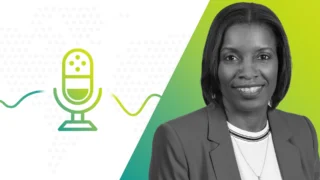
In this episode, we feature the CIA’s Climate Change and Sustainability Committee as it changes over to a new chair. Committee members Houston Cheng, FCIA, Vincent Carrier-Côté, ACIA, and André Choquet, FCIA, join us to discuss the committee’s past successes, goals for the future and how members interested in climate issues can get more involved.
CAN’T LISTEN? READ THE TRANSCRIPT.
Fievoli: Welcome to Seeing Beyond Risk, a podcast series from the Canadian Institute of Actuaries. I’m Chris Fievoli, Actuary, Communications and Public Affairs at the CIA. In this episode, we will be taking a closer look at the CIA’s Climate Change and Sustainability Committee. As it changes leadership, it looks forward to setting priorities for the coming year.
Joining us today are outgoing Chair, André Choquet, incoming Chair, Houston Cheng and committee member, Vincent Carrier-Côté. Thank you all for coming on the podcast.
Choquet: Thank you, Chris.
Cheng: Thanks for inviting us, Chris.
Carrier-Côté: Thanks for having me.
Fievoli: So André, maybe we’ll start with you. I was hoping you’d just give us a brief history of the Climate Change and Sustainability Committee, and also explain to us what the mandate for this group has been.
Choquet: Sure, Chris. The committee started in 2014 under the leadership of Karen Lockridge, FCIA. Other pioneer actuaries have helped move the community forward and gain greater recognition. Pioneers like Catherine Jacques-Brissette, Gaetano Geretto and Eve Guerard to name a few.
The mandate at the beginning was twofold. Raise awareness of the impact of climate change on insurance companies and asset orders – which are, as you know, two major employers of actuaries. And secondly, highlight the role of actuaries in managing risks and bringing solutions. Solutions to the mitigation or adaptation to climate change.
One important realization at that time was the Actuaries Climate Index. This index is an objective measure of changes in extreme weather events. It’s mostly an educational tool, but the data have been used by policymakers as well. It helps build the credibility of the profession in the climate change field. It shows we were getting involved around the same time as the Paris Agreement was getting formed.
Fievoli: So what are some of the issues that the Climate Change and Sustainability Committee has been focusing on recently?
Choquet: I was chair for the last two years and during that time we were responsible for, one, educating actuaries on the relevance of climate change risks to our work, two, spearheading research, three, supporting at advocacy efforts and providing input on public policy and, four, promoting the expertise of actuaries within Canada and internationally in the area of climate related risks.
Can I tell you the accomplishments I’m most proud of during my term?
Fievoli: Absolutely.
Choquet: So, number one, I would say was raising the issue of climate and sustainability to the Board level. In 2022, we created a Steering Committee of the Board to better engage and collaborate across practices. This committee produced the January 2023 climate letter to the membership that Houston will talk about.
Number two, we’ve had lots of engagement with public policymakers like OSFI, the Canadian Association of Pension Supervisory Authorities, CAPSA, and the CSA, the Canadian Securities Administrators, on their guidelines and regulations for the financial sector as it relates to climate. We also provided quality education material for actuaries with several webcasts, sessions at the act meetings and content for actual exams.
One source your listeners should consult is the International Actuarial Association series of papers on climate change and sustainability. Many CIA members have collaborated on almost all of these papers, and I’m really super proud of our Association’s involvement in pushing the frontier of actuarial science.
Finally, the CIA also last year became a supporting member of the United Nations Environment Programme Finance Initiative. It is a consortium of banks, insurers and investors that aim to deliver more sustainable global economies.
Fievoli: Now your current job is kind of interesting because you actually work for an ESG consulting firm. Can you tell us a bit about your role there?
Choquet: I started my career as a pension actuary, and later on I moved to risk management and eventually investment management for asset owners. Now I bring all this background to an ESG advisory firm in Montreal called Millani. We have broadly two types of clients.
Number one, we have asset owners or asset managers for whom we develop a strategy to integrate ESG, including climate related risks, into their investment processes. And the other type of client are corporations for whom we develop a strategy to identify and showcase the key ESG topics that increase enterprise value. So, the interesting part is that these two types of clients are related in that the asset owners and managers end up investing in the corporations that display a good grasp of their ESG topics.
So, my role there at Millani is to work with my colleagues from very different backgrounds. I mean, none of them are actuaries. And together we drive these strategic projects from beginning to end.
Fievoli: Great. And do you have any advice for actuaries that would like to break into this space as part of their practice?
Choquet: For sure, Chris. It’s certain that some level of knowledge of the ESG and climate is needed to get into this space. The field is constantly changing. Actuaries who thought their studying years were over after actuarial exams may not want to apply here. To some extent, you can study on your own. I mean, this is what I did over the years.
In 2016 when I was an investment consultant at a pension consulting firm, I got interested in the space after listening to a talk by David Suzuki that he gave to a group of executives at a conference.And soon after, the Ontario government mandated that pension plans had to include in their investment policy, a statement related to ESG integration.So, I became gradually like the ESG champion in my office and learning through conferences and different sources.
I mean, there’s also the possibility of obtaining a certificate. For example, there are sustainable finance certificates available. One is from our sister organization, the IFOA in the UK. The CFA, the Chartered Financial Analysts, also has one. And some universities offer very good, sustainable finance programs, including my own alma mater, Concordia University in Montreal. So I believe in general actuaries can bring two amazing attributes to this space of climate and sustainability.
At the technical level we’ve been doing complex scenario analysis, stress testing, model building since the dawn of insurance companies. Surely, we have something to say and do when it comes to greenhouse gas emissions, data management or climate scenario analysis.
And secondly, our reputation as a trustworthy profession with a robust code of conduct, professional standards and the disciplinary process brings rigour to a space that sometimes, to be frank, contains a bit of, a bit too much fluff or incomplete analysis.
I think our motto, you know, the work of science is to substitute facts for appearances and demonstrations for impressions, you know suits us well.
Fievoli: OK, great. Thanks for sharing. We’ll turn to Houston now, and we’re going to have a bit of a look forward for the CCSC.
So, I was hoping you could talk to us about what the committee is going to be looking at over the coming year and what are some of the goals you would like to accomplish.
Cheng: Sure. I mean I think a lot of it is really building on the work that, you know, as André put it, some of the “pioneers” have set up. I’ve certainly been aware of the work of the CCSC for quite a while, and I think this coming year is going to be a big year.
So, just getting involved was an interesting aspect, when I was talking to André about the handover as to you know, what work’s been done over the last couple years and what are we looking forward to over the next couple years. And I think this is a bit of a transition time.
So, a lot of the resources that both on the actuarial side, but as well as other areas within the insurance industry are really transitioning from the implementation of IFRS 17 to a different acronym, different set of acronyms.
ESG is definitely getting a lot of airtime now and really just being part of the dialogue that management and boards are having in terms of, you know, what’s the next focus and what kind of risk should management be looking at. Obviously, a big part of it is climate. So, it’s something that’s easy to focus on for different aspects within the actuarial realm.
So obviously on the P&C side we have the physical risk, and on the life and health side there’s a bit of both. Transition and just physical risk and definitely pension. There are hundreds of pensions. There’s lots of issues there that would be climate related. So, what we’re looking forward to is really starting to get the general practitioner involved. And some of it will come from the CIA Board statement that was recently released, and we can talk a bit more about that.
But I think it’s really a couple of key words, collaboration. And collaboration both officially and unofficially within the CIA as well as with other professions and other actuarial organizations. And how we see that is that we want to foster a bit of a collaboration with between, you know, the CCSC, so the Climate Change and Sustainability Committee, as well as other committees within CIA that, you know, will be impacted by this.
And what we’re seeing is OSFI is going to be releasing Guideline B-15 very shortly. You know, by the time I think the podcast is out, the final guideline, B-15, will be out already. And there’s going to be other work that actually we’ll have to do as well, especially insurance side, in terms of considering climate related risks in financial condition testing, as well as any upcoming regulatory standardized stress testing and scenario tests.
What we want to do is collaborate with various committees such as the PCFRC, Clifford, PPFRC to form a working group so that, you know, we can provide tools and a bit of a think tank for actuaries to look through. Well how do we start this thing, what do we do to motivate and educate our community on how climate risk ought to be considered within the actuarial work?
And we’re also working with the education side, as André had put so eloquently that, you know, we are trying to educate the actuarial community as to whether there’s areas that you got to start with, there’s a lot of other work that’s been done from parties outside of the CIA and also outside of Canada. So we want to bring some of that at the climate change and sustainability symposium. So that’s another thing that the CCSC is working on.
And the last thing is we want to continue some of the research efforts that’s been suggested or has been put into motion from the CCSC. So, we’re working with different research ideas and get some of those off the ground so that we can help actuaries integrate climate risk into our work.
Fievoli: Yeah. Let’s turn back to that Board statement that you’ve mentioned a moment ago on climate issues. Can you give us a summary of what was in that statement and what should CIA members take away from that?
Cheng: I mean, I think a lot of the summary was actually discussed from André’s perspective already, but it really just kicks off by stating that the CIA supports the United Nations Environment Programme Finance Initiative.
Here really, it’s two main points. So, CIA is committed to sharing our expertise on a national and global level and that the CIA is going to undertake research and providing guidance and support to the actuarial profession. So, both of those are key areas for being supportive of this initiative from the UN.
Other areas that the statement had kind of discussed was highlighting some of the key global initiatives that are relevant to our field of practice.
So, from the creation of the International Sustainability Standards Board to OSFIS’s B-15, which we mentioned already, to some of Bank of Canada’s use of scenario analysis as well as CAPSA, so, the Canadian Association of Pension supervisory authorities. So, work that all of these different, either regulatory or financial organizations have put together and set forth on. So just highlighting that, you know, there’s a lot of reasons why we ought to consider and be on top of the climate change and climate risk.
Other areas that the statement covered was giving some examples. So just putting some pen to paper as to what are the risks. We talked about physical risks, transition risk and liability risk and what do they mean? Kind of putting that from the insurance perspective and pension perspective as to where might you see some of these risks, so that, you know, you don’t have to dig too far or dig too deep to certain of these areas so that you can picture what are we working towards.
But the main thing really is a call to action. I think this is something that I personally have been trying to see what can we do as an actuarial profession. We know this is something that’s been discussed for quite a while at various levels. The CCSC was formed specifically for this purpose, and I think it really speaks to André’s point again.
This is our skill set and we have a professional framework that allows us to be credible in terms of performing some of this work. So, I think we have a key role to play – especially in our traditional areas of practice. Whether we practice in insurance, be it P&C or life and health, as well as well as pension and investment. This is our bread and butter, and this is where we need to know how climate impacts our work.
We need to know how to integrate the considerations for climate risk into our work. And that’s where we need to focus on. Just, everyone is in this together, and we got to have a bit of a wake-up call that this is the year. This is the year that we need to start working together on it.
Fievoli: OK, great. Well, best of luck in your new role as chair. And now we’ll turn to Vincent, who’s also a member of the committee. And I was hoping you could jump in and give us just description of your current job and how do climate issues and climate considerations affect your day-to-day practice.
Carrier-Côté: I’m a manager in EY’s life insurance and actuarial advisory services practice. I will start off by saying that climate risk and, you know, sustainability is not necessarily my day job. Although, I would say that is starting to change at least to some extent, and we can get into the how and the why behind that in a moment.
So, my areas of focus have been a bit more traditional in the life insurance consulting space. I did a lot of actuarial modelling work especially early on in my career, built a pretty good foundation and GGY AXIS software. I’ve done a good amount of financial reporting more recently focused on IFRS 17, which I think has been kind of a good launching pad for some of the work that’s more climate related that I’ve started doing recently. And again, we’ll cover that in a second.
And then recently I’ve done quite a bit of more strategic reinsurance work. Things like enforce management as well as helping insurers look at strategies to optimize their capital, notably looking at setting up reinsurance entities and other jurisdictions like Bermuda.
Fievoli: I was hoping you could give us a bit of advice for younger CIA members or newer members that want to get more deeply involved in climate issues. What are some of the things that they can do?
Carrier-Côté: I would say one, definitely sign up for internal initiatives at work. And I would say don’t be shy about expressing your interest in those topics to your colleagues. For example, in my case, you know I made it a point to connect with other practices within my firm.
So, for example, I reached out to some of my colleagues in the UK actuarial practice because, you know, as you probably know, Europe and the UK in particular are a lot more advanced than the space. They’re probably several years ahead of us here in North America, and that’s in large part due to them having more regulation over there.
So I got to know them, I got to know what they’re doing. I also connected with folks from our insurance accounting and climate change and sustainability practices, you know, that are more climate experts. And, their projects, while they’re not necessarily actuarial in nature, they’re a pretty good entry point to our own clients in actuarial. So, we often share the same clients, in particular with insurance accounting. So, I would say that reaching out to those folks really helped me learn about the subject matter, but also about the kind of work that insurers are currently doing in this space.
It also helped me develop my network and that space and, you know, advertised the actuary’s role as well. I’ve felt quite a bit of support from leadership at my firm. So, I would say, you know, leadership’s often looking for individuals that want to own this stuff and that want to be the go-to person. So, it’s pretty important I think to get a foot in the door early if possible if you’re interested in those topics.
So, that would be one. I would say also, if you’re someone like me where climate risk is not necessarily your day job, I would say look for connections between climate considerations and what actually is your bread and butter that can then help make climate risk a bigger component of your day job.
So, one example that is probably relevant for many Canadian actuaries is the establishment of the ISSB, International Sustainability Standards Board, by the IFRS Foundation. I say it’s probably relevant to many Canadian actuaries because that is an entity under the umbrella of the IFRS Foundation, and they actually have offices in Montreal. And, their objective is to develop global sustainability related disclosure standards. I think they actually have plans to start issuing standards later this year.
And, I think that a lot of actuaries in Canada have probably spent the last few years working on IFRS 17 related initiatives. So, getting familiar with insurance accounting standards, you know, in terms of external reporting and disclosures. And so, I think pivoting to ISSB standards, you know, if there’s interest, may be kind of a natural fit for those actuaries.
A more personal example for me that’s led to some real concrete work in this space is… So, I mentioned earlier that, you know, I’ve done some work to help insurers look at the feasibility of establishing Bermuda reinsurance entities, which sounds very niche and not related to climate risk at all. But recently the Bermuda Monetary Authority that the regulator over there issued a guidance note on the management of climate change risks.
And so, one of our prior insurance clients reached out to colleagues in line to help them develop a current state assessment and a road map towards compliance with the BMA’s expectations, and I was able to get involved with that project, through my prior work in that jurisdiction and the relationships I’d built with our colleagues over there.
So, all that to say that it might start out as being more in the periphery of your day job, but there are definitely ways to make it a bigger component of it if you look for them and if you have an open mind. And then maybe I’ll say as well, you know, I would make it a point to stay up to date with publications and research in the space.
A really good example of something that was kind of an entry point for me were the IAA’s series of papers published by their Climate Risk Task Force, and that, you know, that are really targeted to actuaries. I would also say, you know, look at what some standard-setting bodies are publishing like the Task Force for Climate Related Financial Disclosures and then even our own committee. If you go on the CIA’s CCSC resources page, we have a pretty good list of resources there.
So I found it useful to compile kind of my own little library of useful resources to sift through at my own pace and get educated on the topics.
Choquet: Can I add something, Chris?
Fievoli: Yes, absolutely. Go ahead.
Choquet: Just wanted to add, Vincent you forgot maybe applying to this CCSC might be another way of getting involved. And, I remember Vincent actually reached out to me when I was chair of the CCSC, and I really liked his enthusiasm and his desire to get involved with climate change and sustainability. So, there he is now, a part of the committee. That could be somebody else in the audience.
Carrier-Côté: Absolutely. Thanks, André.
Fievoli: Yeah, fantastic. We’re always happy to get more volunteers, so that’s great. We covered a lot of ground today. So, thanks everyone for coming on today’s episode.
Cheng: Thank you again, Chris.
Choquet: Thank you, Chris.
Carrier-Côté: Awesome. Thanks Chris.
Fievoli: If you enjoy today’s conversation, we invite you to subscribe to our podcast series and catch up on prior episodes. As well, if you have any ideas for a future episode or you would like to contribute to our Seeing Beyond Risk blog, we would love to hear from you. Contact information can be found in the show description.
Until next time, I’m Chris Fievoli, and thank you for tuning in to Seeing Beyond Risk.
This transcript has been edited for clarity.





